Managing Finance Coursework: Analysis of Boohoo Group's Financial Ratios
VerifiedAdded on 2023/06/14
|12
|2481
|198
AI Summary
This report analyzes the financial ratios of Boohoo Group, a British online fashion retailer, and provides recommendations for better performance. The report considers the annual reports of the business from the year 2019, 2020 and 2021.
Contribute Materials
Your contribution can guide someone’s learning journey. Share your
documents today.

1. MANAGING
FINANCE
Coursework
FINANCE
Coursework
Secure Best Marks with AI Grader
Need help grading? Try our AI Grader for instant feedback on your assignments.

EXECUTIVE SUMMARY
Management of Finance and the financial resources of the business is a major concept in a
business. This management is done using different tools discussed in the management theory.
Interpretation of the financial ratios is one of the major tools used to forecast the performance of
the business and provide changes in the business which are required to do better in the
marketplace. This report highlights the usage of financial ratios in the case of Boohoo Group, A
British online fashion retailer. Interpretation of the ratios and recommendations are provided to
the business. The report considers the annual reports of the business from the year 2019, 2020
and 2021.
Management of Finance and the financial resources of the business is a major concept in a
business. This management is done using different tools discussed in the management theory.
Interpretation of the financial ratios is one of the major tools used to forecast the performance of
the business and provide changes in the business which are required to do better in the
marketplace. This report highlights the usage of financial ratios in the case of Boohoo Group, A
British online fashion retailer. Interpretation of the ratios and recommendations are provided to
the business. The report considers the annual reports of the business from the year 2019, 2020
and 2021.
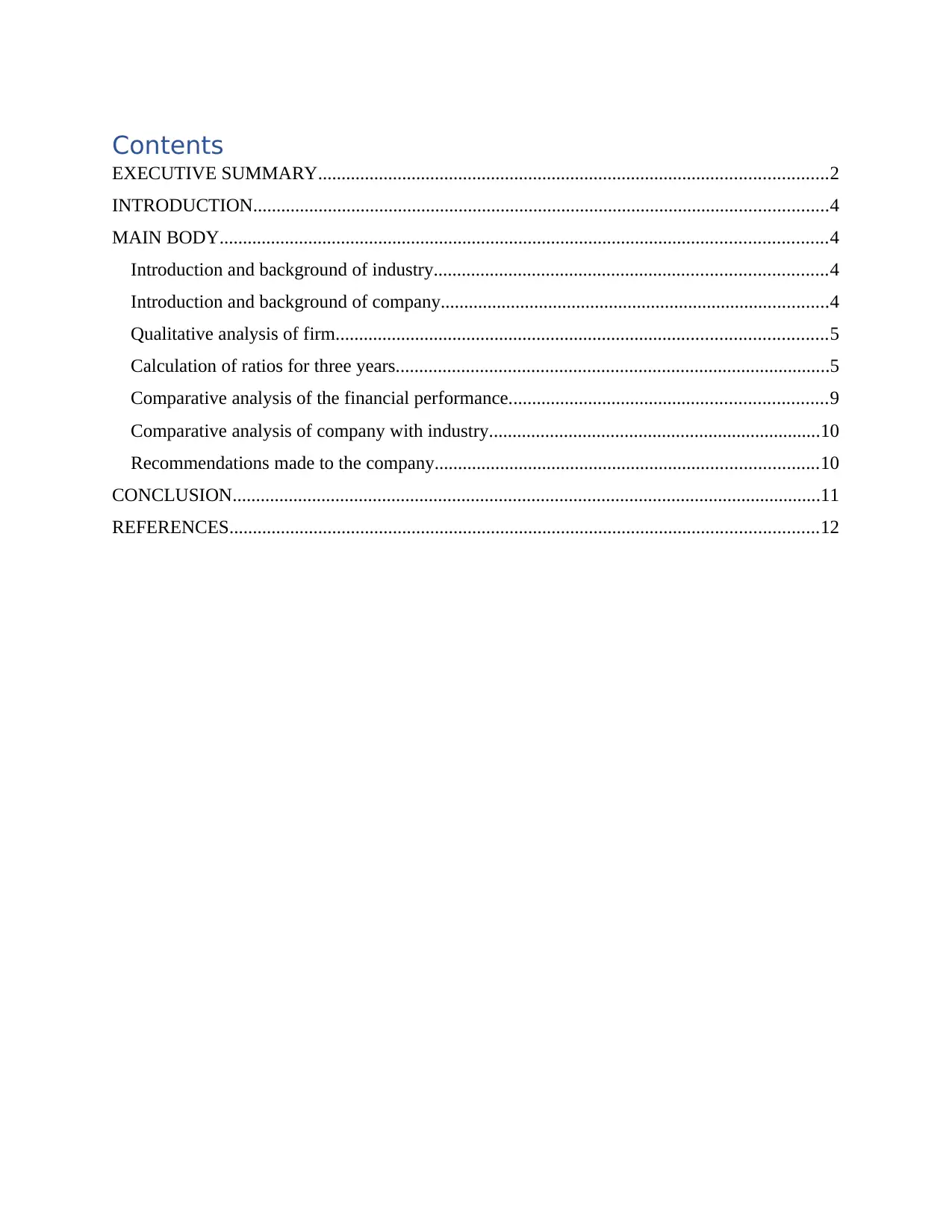
Contents
EXECUTIVE SUMMARY.............................................................................................................2
INTRODUCTION...........................................................................................................................4
MAIN BODY..................................................................................................................................4
Introduction and background of industry....................................................................................4
Introduction and background of company...................................................................................4
Qualitative analysis of firm.........................................................................................................5
Calculation of ratios for three years.............................................................................................5
Comparative analysis of the financial performance....................................................................9
Comparative analysis of company with industry.......................................................................10
Recommendations made to the company..................................................................................10
CONCLUSION..............................................................................................................................11
REFERENCES..............................................................................................................................12
EXECUTIVE SUMMARY.............................................................................................................2
INTRODUCTION...........................................................................................................................4
MAIN BODY..................................................................................................................................4
Introduction and background of industry....................................................................................4
Introduction and background of company...................................................................................4
Qualitative analysis of firm.........................................................................................................5
Calculation of ratios for three years.............................................................................................5
Comparative analysis of the financial performance....................................................................9
Comparative analysis of company with industry.......................................................................10
Recommendations made to the company..................................................................................10
CONCLUSION..............................................................................................................................11
REFERENCES..............................................................................................................................12

INTRODUCTION
Management refers to the process of organising all of one's work in order to attain a specific
organisational goal. In financial accounting, it involves managing a company's financial
resources in such a way that wealth and earnings are maximised. If huge businesses wish to grow
consistently, they should compare their results to those of their competitors (Jackson, 2020). It
will assist them in determining where they are falling short and where they need to improve.
Boohoo Group is the company profiled in this research. It is a Manchester-based online fashion
retailer with headquarters in the United Kingdom. The report goes through the history of the
chosen industry as well as the history of the company. In addition to ratio calculations, it
conducts subjective analysis of the company. It also examines the firm's performance and
compares it to that of comparable businesses and provides recommendations to the Boohoo
Group.
MAIN BODY
Introduction and background of industry.
The fashion sector in the United Kingdom plays a significant part in boosting the country's
economy (Kim, and Kim, 2019). The demand for attractive clothing in the United Kingdom is
increasing as the population grows and individuals become more aware of fashion. The history
of this sector is extensive, and it has evolved and transformed significantly over time to include
some of the world's best fashion designers. It was 1984, and a lady placed an order for groceries
by calling a grocery store after checking the item list on a computer. Following then, the online
shopping craze began (Shimizutani, and Yamada, 2018.). This began with product commercials
on television and gradually progressed to selling things while providing them on the internet.
Companies now have their own portal where customers may choose the goods they want to buy
and place an order without having to deal with the vendor in person. Similarly, fashion industry
strata showcase their products on their websites in order to entice clients to buy them. This has
supplied buyers with a pool of options from which to select their desired items.
Introduction and background of company.
The Boohoo Group is a British online fashion retailer that was started in 2006. It sells over
36000 different items. Many firms and online stores have been bought by it. Mahmud Kamani
and Corol Kane, who is currently the company's chairman, formed the company. The company
Management refers to the process of organising all of one's work in order to attain a specific
organisational goal. In financial accounting, it involves managing a company's financial
resources in such a way that wealth and earnings are maximised. If huge businesses wish to grow
consistently, they should compare their results to those of their competitors (Jackson, 2020). It
will assist them in determining where they are falling short and where they need to improve.
Boohoo Group is the company profiled in this research. It is a Manchester-based online fashion
retailer with headquarters in the United Kingdom. The report goes through the history of the
chosen industry as well as the history of the company. In addition to ratio calculations, it
conducts subjective analysis of the company. It also examines the firm's performance and
compares it to that of comparable businesses and provides recommendations to the Boohoo
Group.
MAIN BODY
Introduction and background of industry.
The fashion sector in the United Kingdom plays a significant part in boosting the country's
economy (Kim, and Kim, 2019). The demand for attractive clothing in the United Kingdom is
increasing as the population grows and individuals become more aware of fashion. The history
of this sector is extensive, and it has evolved and transformed significantly over time to include
some of the world's best fashion designers. It was 1984, and a lady placed an order for groceries
by calling a grocery store after checking the item list on a computer. Following then, the online
shopping craze began (Shimizutani, and Yamada, 2018.). This began with product commercials
on television and gradually progressed to selling things while providing them on the internet.
Companies now have their own portal where customers may choose the goods they want to buy
and place an order without having to deal with the vendor in person. Similarly, fashion industry
strata showcase their products on their websites in order to entice clients to buy them. This has
supplied buyers with a pool of options from which to select their desired items.
Introduction and background of company.
The Boohoo Group is a British online fashion retailer that was started in 2006. It sells over
36000 different items. Many firms and online stores have been bought by it. Mahmud Kamani
and Corol Kane, who is currently the company's chairman, formed the company. The company
Secure Best Marks with AI Grader
Need help grading? Try our AI Grader for instant feedback on your assignments.
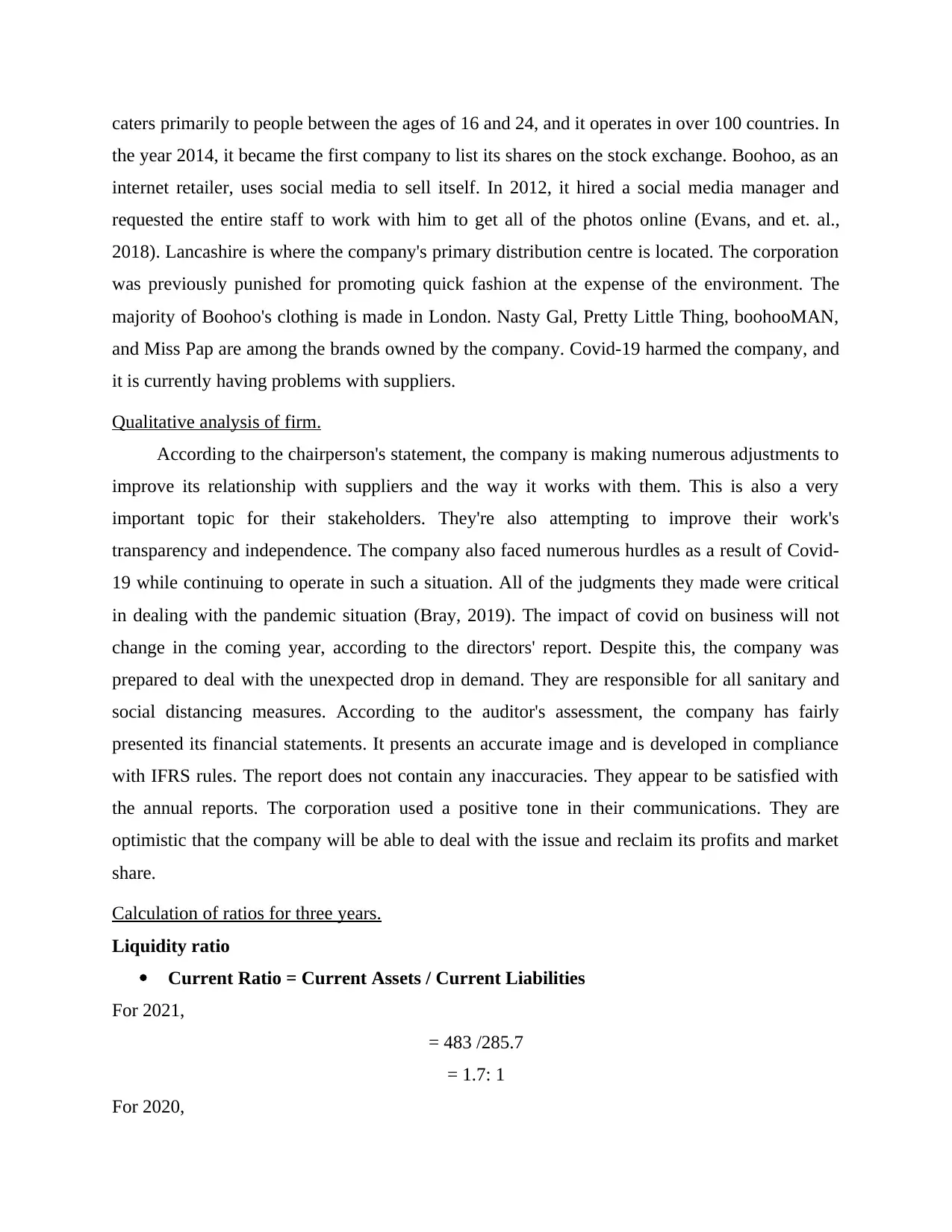
caters primarily to people between the ages of 16 and 24, and it operates in over 100 countries. In
the year 2014, it became the first company to list its shares on the stock exchange. Boohoo, as an
internet retailer, uses social media to sell itself. In 2012, it hired a social media manager and
requested the entire staff to work with him to get all of the photos online (Evans, and et. al.,
2018). Lancashire is where the company's primary distribution centre is located. The corporation
was previously punished for promoting quick fashion at the expense of the environment. The
majority of Boohoo's clothing is made in London. Nasty Gal, Pretty Little Thing, boohooMAN,
and Miss Pap are among the brands owned by the company. Covid-19 harmed the company, and
it is currently having problems with suppliers.
Qualitative analysis of firm.
According to the chairperson's statement, the company is making numerous adjustments to
improve its relationship with suppliers and the way it works with them. This is also a very
important topic for their stakeholders. They're also attempting to improve their work's
transparency and independence. The company also faced numerous hurdles as a result of Covid-
19 while continuing to operate in such a situation. All of the judgments they made were critical
in dealing with the pandemic situation (Bray, 2019). The impact of covid on business will not
change in the coming year, according to the directors' report. Despite this, the company was
prepared to deal with the unexpected drop in demand. They are responsible for all sanitary and
social distancing measures. According to the auditor's assessment, the company has fairly
presented its financial statements. It presents an accurate image and is developed in compliance
with IFRS rules. The report does not contain any inaccuracies. They appear to be satisfied with
the annual reports. The corporation used a positive tone in their communications. They are
optimistic that the company will be able to deal with the issue and reclaim its profits and market
share.
Calculation of ratios for three years.
Liquidity ratio
Current Ratio = Current Assets / Current Liabilities
For 2021,
= 483 /285.7
= 1.7: 1
For 2020,
the year 2014, it became the first company to list its shares on the stock exchange. Boohoo, as an
internet retailer, uses social media to sell itself. In 2012, it hired a social media manager and
requested the entire staff to work with him to get all of the photos online (Evans, and et. al.,
2018). Lancashire is where the company's primary distribution centre is located. The corporation
was previously punished for promoting quick fashion at the expense of the environment. The
majority of Boohoo's clothing is made in London. Nasty Gal, Pretty Little Thing, boohooMAN,
and Miss Pap are among the brands owned by the company. Covid-19 harmed the company, and
it is currently having problems with suppliers.
Qualitative analysis of firm.
According to the chairperson's statement, the company is making numerous adjustments to
improve its relationship with suppliers and the way it works with them. This is also a very
important topic for their stakeholders. They're also attempting to improve their work's
transparency and independence. The company also faced numerous hurdles as a result of Covid-
19 while continuing to operate in such a situation. All of the judgments they made were critical
in dealing with the pandemic situation (Bray, 2019). The impact of covid on business will not
change in the coming year, according to the directors' report. Despite this, the company was
prepared to deal with the unexpected drop in demand. They are responsible for all sanitary and
social distancing measures. According to the auditor's assessment, the company has fairly
presented its financial statements. It presents an accurate image and is developed in compliance
with IFRS rules. The report does not contain any inaccuracies. They appear to be satisfied with
the annual reports. The corporation used a positive tone in their communications. They are
optimistic that the company will be able to deal with the issue and reclaim its profits and market
share.
Calculation of ratios for three years.
Liquidity ratio
Current Ratio = Current Assets / Current Liabilities
For 2021,
= 483 /285.7
= 1.7: 1
For 2020,

= 382.9/ 217.9
= 1.7: 1
For 2019,
= 296323 / 162093
= 1.82 : 1
Acid Test Ratio = Current Assets - Inventory / Current Liabilities
For 2021,
= 483– 144.9/ 285.7
= 338.1/ 285.7
=1.18: 1
For 2020,
= 382.9– 99.1 / 217.9
= 283.8/ 217.9
= 1.30: 1
For 2019,
= 296323 – 66,806 / 162093
= 229517 / 162093
= 1.41 : 1
Profitability ratio
Net operating profit Ratio = Operating Profit / Revenue * 100
For 2021,
= 124.1 /1745.3 *100
= 7.11 %
For 2020,
= 90.9 /1234.9 *100
= 7.36 %
For 2019,
= 58,680 / 856,920 * 100
= 6.84 %
Net Profit Ratio = Net Profit / Revenue * 100
For 2021,
= 1.7: 1
For 2019,
= 296323 / 162093
= 1.82 : 1
Acid Test Ratio = Current Assets - Inventory / Current Liabilities
For 2021,
= 483– 144.9/ 285.7
= 338.1/ 285.7
=1.18: 1
For 2020,
= 382.9– 99.1 / 217.9
= 283.8/ 217.9
= 1.30: 1
For 2019,
= 296323 – 66,806 / 162093
= 229517 / 162093
= 1.41 : 1
Profitability ratio
Net operating profit Ratio = Operating Profit / Revenue * 100
For 2021,
= 124.1 /1745.3 *100
= 7.11 %
For 2020,
= 90.9 /1234.9 *100
= 7.36 %
For 2019,
= 58,680 / 856,920 * 100
= 6.84 %
Net Profit Ratio = Net Profit / Revenue * 100
For 2021,

= 93.4 /1745.3 *100
= 5.35 %
For 2020,
= 72.9 /1234.9 *100
= 5.90 %
For 2019,
= 47,459 / 856,920 * 100
= 5.53 %
Return on Investment = Net profit before interest, tax and Dividend / Capital
Employed * 100
For 2021,
= 124.1 / (775.9 -285.7) * 100
= 124.1 –490.2
= 25.31%
For 2020,
= 90.9 / (569.5 –217.9) * 100
= 90.9 /351.6 * 100
= 25.85 %
For 2019,
= 58,680 / ( 439,776 – 162,093 ) * 100
= 58,680 / 277683 * 100
= 21.13 %
Solvency ratio
Debt to equity Ratio = Total debt / Shareholders funds
For 2021,
= 303.4 / 472.5
= 0.41
For 2020,
= 241.6 / 327.9
= 0.73
For 2019,
= 5.35 %
For 2020,
= 72.9 /1234.9 *100
= 5.90 %
For 2019,
= 47,459 / 856,920 * 100
= 5.53 %
Return on Investment = Net profit before interest, tax and Dividend / Capital
Employed * 100
For 2021,
= 124.1 / (775.9 -285.7) * 100
= 124.1 –490.2
= 25.31%
For 2020,
= 90.9 / (569.5 –217.9) * 100
= 90.9 /351.6 * 100
= 25.85 %
For 2019,
= 58,680 / ( 439,776 – 162,093 ) * 100
= 58,680 / 277683 * 100
= 21.13 %
Solvency ratio
Debt to equity Ratio = Total debt / Shareholders funds
For 2021,
= 303.4 / 472.5
= 0.41
For 2020,
= 241.6 / 327.9
= 0.73
For 2019,
Paraphrase This Document
Need a fresh take? Get an instant paraphrase of this document with our AI Paraphraser
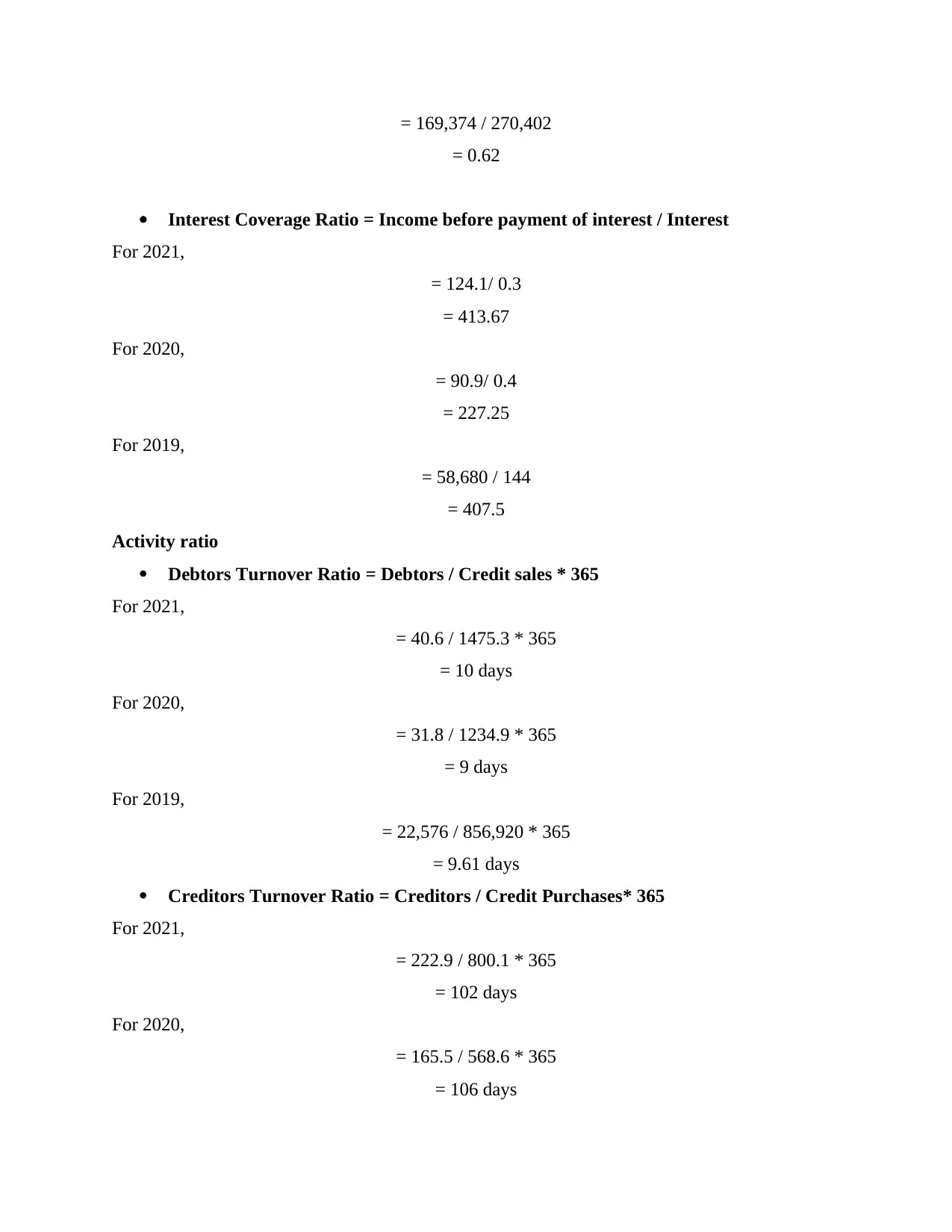
= 169,374 / 270,402
= 0.62
Interest Coverage Ratio = Income before payment of interest / Interest
For 2021,
= 124.1/ 0.3
= 413.67
For 2020,
= 90.9/ 0.4
= 227.25
For 2019,
= 58,680 / 144
= 407.5
Activity ratio
Debtors Turnover Ratio = Debtors / Credit sales * 365
For 2021,
= 40.6 / 1475.3 * 365
= 10 days
For 2020,
= 31.8 / 1234.9 * 365
= 9 days
For 2019,
= 22,576 / 856,920 * 365
= 9.61 days
Creditors Turnover Ratio = Creditors / Credit Purchases* 365
For 2021,
= 222.9 / 800.1 * 365
= 102 days
For 2020,
= 165.5 / 568.6 * 365
= 106 days
= 0.62
Interest Coverage Ratio = Income before payment of interest / Interest
For 2021,
= 124.1/ 0.3
= 413.67
For 2020,
= 90.9/ 0.4
= 227.25
For 2019,
= 58,680 / 144
= 407.5
Activity ratio
Debtors Turnover Ratio = Debtors / Credit sales * 365
For 2021,
= 40.6 / 1475.3 * 365
= 10 days
For 2020,
= 31.8 / 1234.9 * 365
= 9 days
For 2019,
= 22,576 / 856,920 * 365
= 9.61 days
Creditors Turnover Ratio = Creditors / Credit Purchases* 365
For 2021,
= 222.9 / 800.1 * 365
= 102 days
For 2020,
= 165.5 / 568.6 * 365
= 106 days
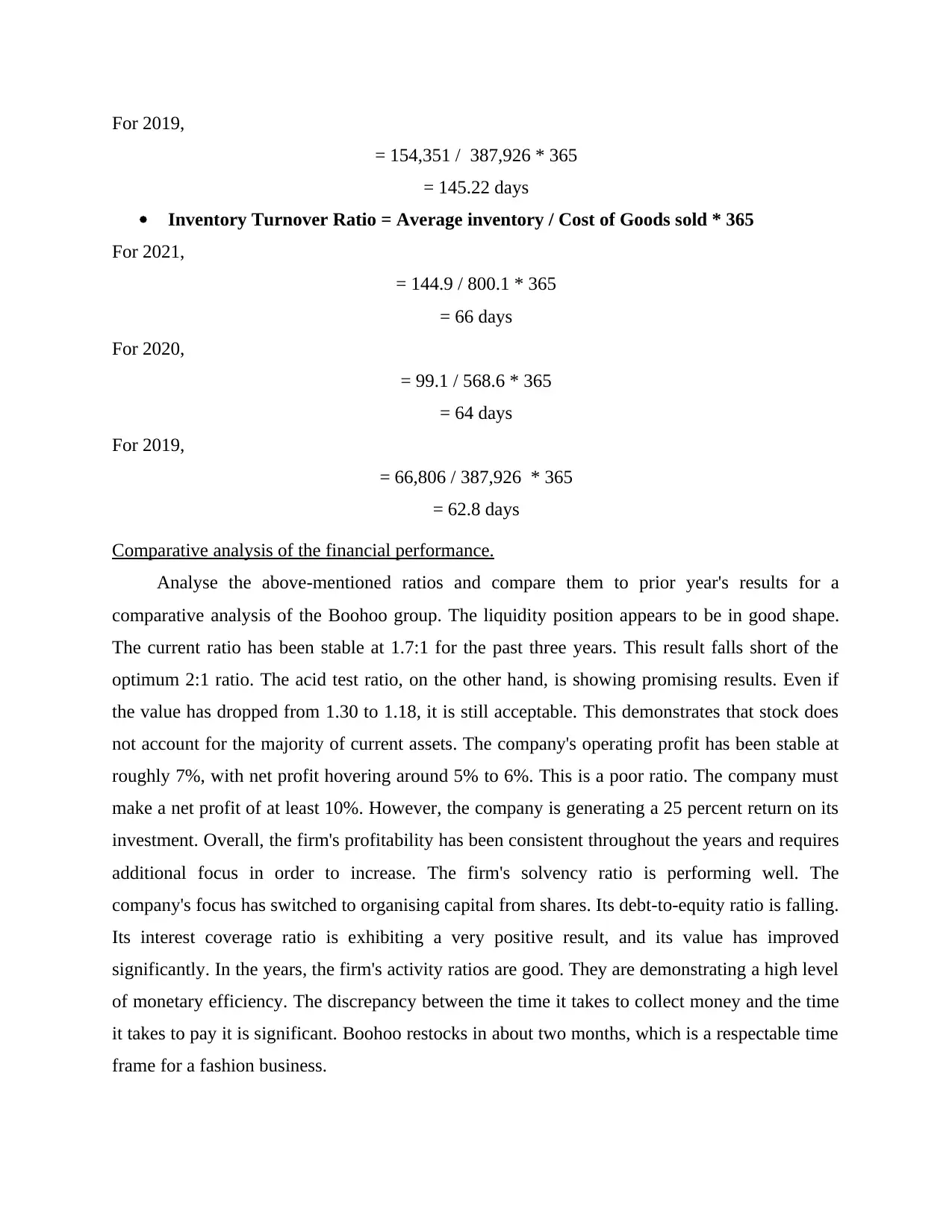
For 2019,
= 154,351 / 387,926 * 365
= 145.22 days
Inventory Turnover Ratio = Average inventory / Cost of Goods sold * 365
For 2021,
= 144.9 / 800.1 * 365
= 66 days
For 2020,
= 99.1 / 568.6 * 365
= 64 days
For 2019,
= 66,806 / 387,926 * 365
= 62.8 days
Comparative analysis of the financial performance.
Analyse the above-mentioned ratios and compare them to prior year's results for a
comparative analysis of the Boohoo group. The liquidity position appears to be in good shape.
The current ratio has been stable at 1.7:1 for the past three years. This result falls short of the
optimum 2:1 ratio. The acid test ratio, on the other hand, is showing promising results. Even if
the value has dropped from 1.30 to 1.18, it is still acceptable. This demonstrates that stock does
not account for the majority of current assets. The company's operating profit has been stable at
roughly 7%, with net profit hovering around 5% to 6%. This is a poor ratio. The company must
make a net profit of at least 10%. However, the company is generating a 25 percent return on its
investment. Overall, the firm's profitability has been consistent throughout the years and requires
additional focus in order to increase. The firm's solvency ratio is performing well. The
company's focus has switched to organising capital from shares. Its debt-to-equity ratio is falling.
Its interest coverage ratio is exhibiting a very positive result, and its value has improved
significantly. In the years, the firm's activity ratios are good. They are demonstrating a high level
of monetary efficiency. The discrepancy between the time it takes to collect money and the time
it takes to pay it is significant. Boohoo restocks in about two months, which is a respectable time
frame for a fashion business.
= 154,351 / 387,926 * 365
= 145.22 days
Inventory Turnover Ratio = Average inventory / Cost of Goods sold * 365
For 2021,
= 144.9 / 800.1 * 365
= 66 days
For 2020,
= 99.1 / 568.6 * 365
= 64 days
For 2019,
= 66,806 / 387,926 * 365
= 62.8 days
Comparative analysis of the financial performance.
Analyse the above-mentioned ratios and compare them to prior year's results for a
comparative analysis of the Boohoo group. The liquidity position appears to be in good shape.
The current ratio has been stable at 1.7:1 for the past three years. This result falls short of the
optimum 2:1 ratio. The acid test ratio, on the other hand, is showing promising results. Even if
the value has dropped from 1.30 to 1.18, it is still acceptable. This demonstrates that stock does
not account for the majority of current assets. The company's operating profit has been stable at
roughly 7%, with net profit hovering around 5% to 6%. This is a poor ratio. The company must
make a net profit of at least 10%. However, the company is generating a 25 percent return on its
investment. Overall, the firm's profitability has been consistent throughout the years and requires
additional focus in order to increase. The firm's solvency ratio is performing well. The
company's focus has switched to organising capital from shares. Its debt-to-equity ratio is falling.
Its interest coverage ratio is exhibiting a very positive result, and its value has improved
significantly. In the years, the firm's activity ratios are good. They are demonstrating a high level
of monetary efficiency. The discrepancy between the time it takes to collect money and the time
it takes to pay it is significant. Boohoo restocks in about two months, which is a respectable time
frame for a fashion business.
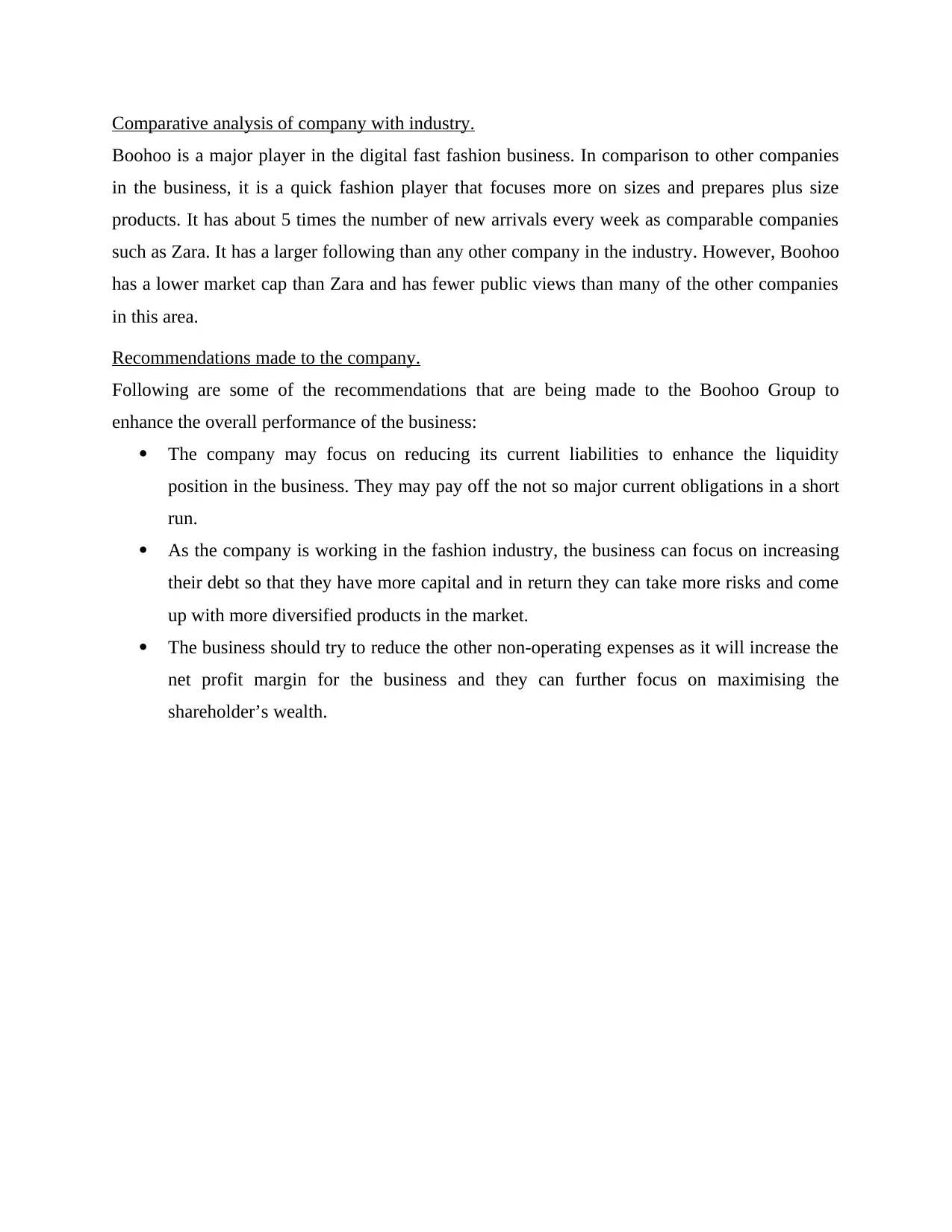
Comparative analysis of company with industry.
Boohoo is a major player in the digital fast fashion business. In comparison to other companies
in the business, it is a quick fashion player that focuses more on sizes and prepares plus size
products. It has about 5 times the number of new arrivals every week as comparable companies
such as Zara. It has a larger following than any other company in the industry. However, Boohoo
has a lower market cap than Zara and has fewer public views than many of the other companies
in this area.
Recommendations made to the company.
Following are some of the recommendations that are being made to the Boohoo Group to
enhance the overall performance of the business:
The company may focus on reducing its current liabilities to enhance the liquidity
position in the business. They may pay off the not so major current obligations in a short
run.
As the company is working in the fashion industry, the business can focus on increasing
their debt so that they have more capital and in return they can take more risks and come
up with more diversified products in the market.
The business should try to reduce the other non-operating expenses as it will increase the
net profit margin for the business and they can further focus on maximising the
shareholder’s wealth.
Boohoo is a major player in the digital fast fashion business. In comparison to other companies
in the business, it is a quick fashion player that focuses more on sizes and prepares plus size
products. It has about 5 times the number of new arrivals every week as comparable companies
such as Zara. It has a larger following than any other company in the industry. However, Boohoo
has a lower market cap than Zara and has fewer public views than many of the other companies
in this area.
Recommendations made to the company.
Following are some of the recommendations that are being made to the Boohoo Group to
enhance the overall performance of the business:
The company may focus on reducing its current liabilities to enhance the liquidity
position in the business. They may pay off the not so major current obligations in a short
run.
As the company is working in the fashion industry, the business can focus on increasing
their debt so that they have more capital and in return they can take more risks and come
up with more diversified products in the market.
The business should try to reduce the other non-operating expenses as it will increase the
net profit margin for the business and they can further focus on maximising the
shareholder’s wealth.
Secure Best Marks with AI Grader
Need help grading? Try our AI Grader for instant feedback on your assignments.
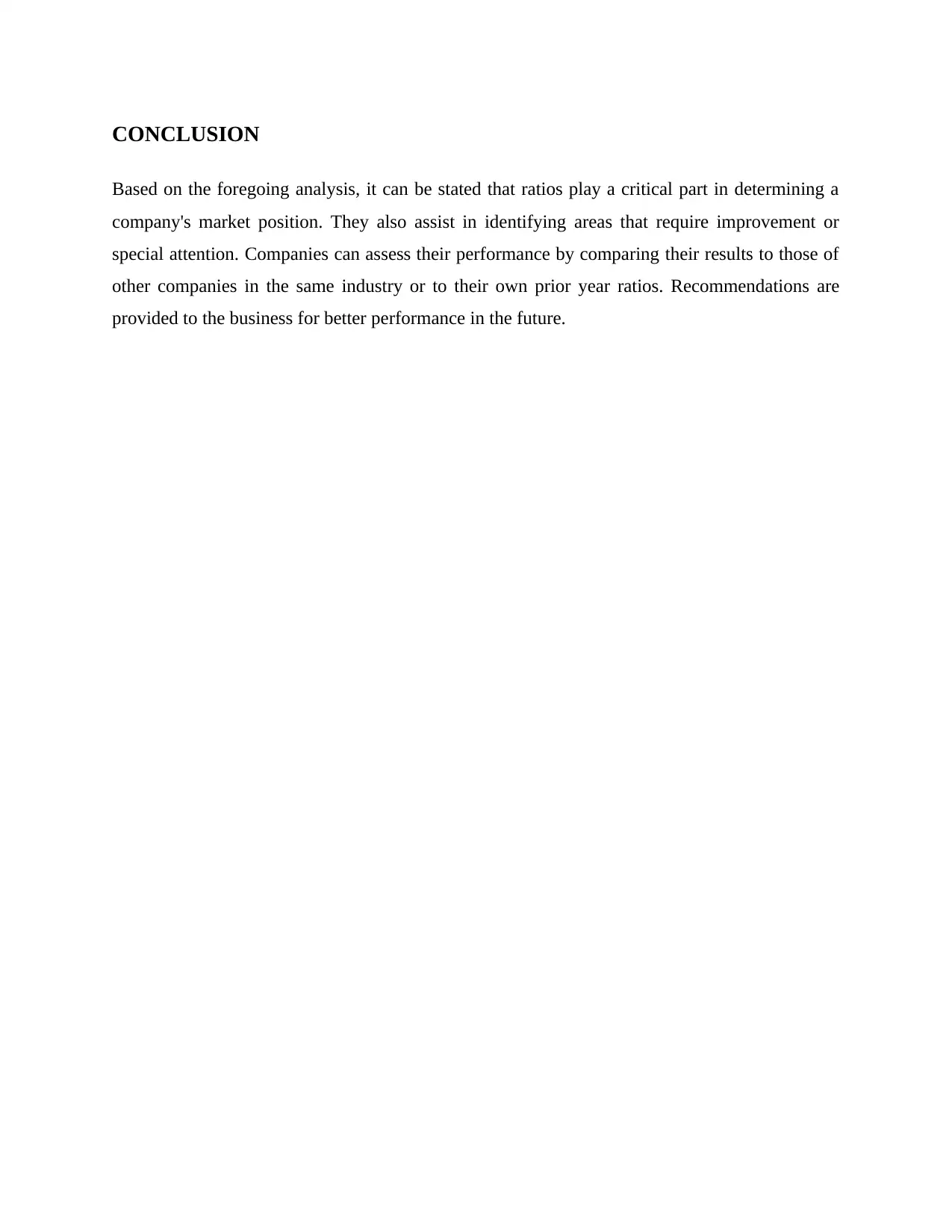
CONCLUSION
Based on the foregoing analysis, it can be stated that ratios play a critical part in determining a
company's market position. They also assist in identifying areas that require improvement or
special attention. Companies can assess their performance by comparing their results to those of
other companies in the same industry or to their own prior year ratios. Recommendations are
provided to the business for better performance in the future.
Based on the foregoing analysis, it can be stated that ratios play a critical part in determining a
company's market position. They also assist in identifying areas that require improvement or
special attention. Companies can assess their performance by comparing their results to those of
other companies in the same industry or to their own prior year ratios. Recommendations are
provided to the business for better performance in the future.
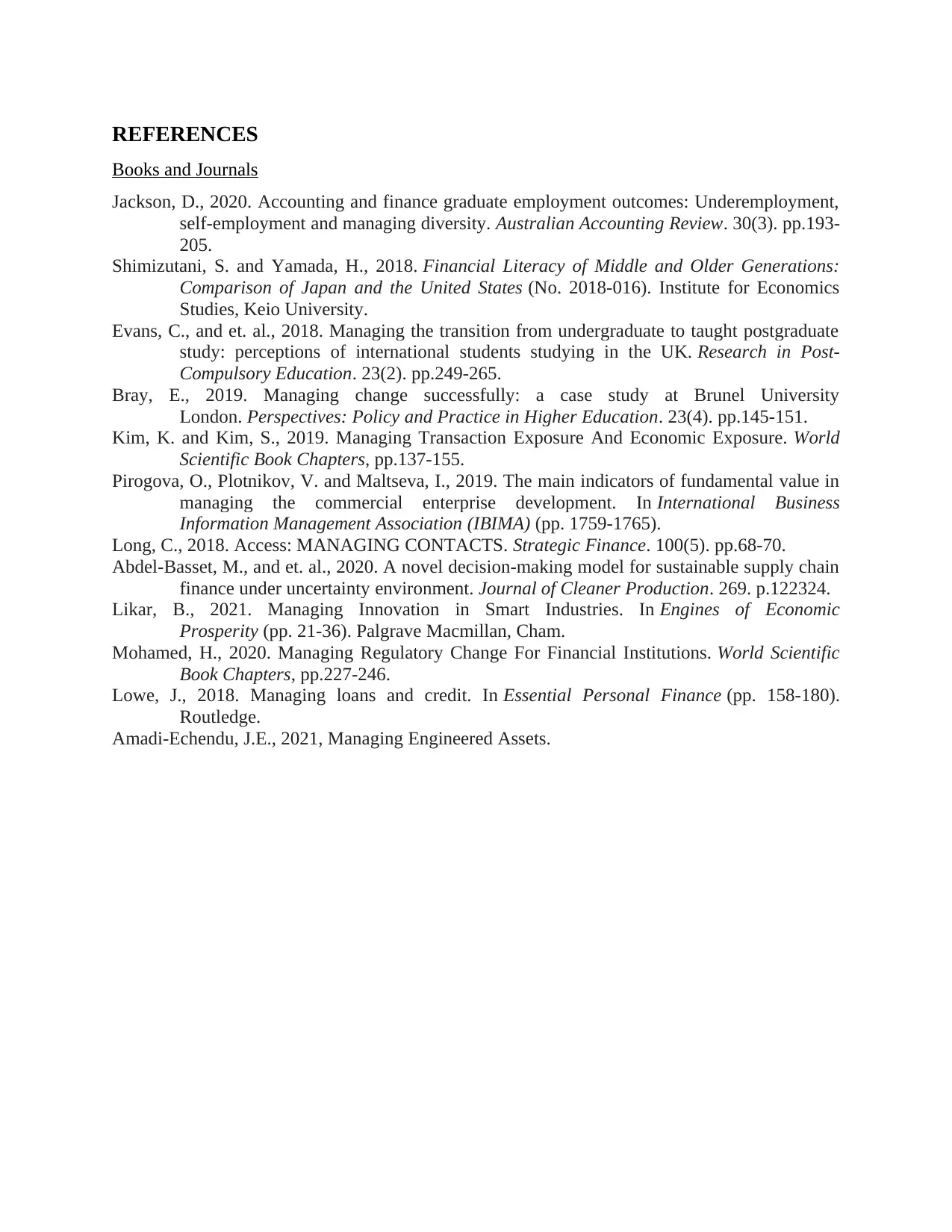
REFERENCES
Books and Journals
Jackson, D., 2020. Accounting and finance graduate employment outcomes: Underemployment,
self‐employment and managing diversity. Australian Accounting Review. 30(3). pp.193-
205.
Shimizutani, S. and Yamada, H., 2018. Financial Literacy of Middle and Older Generations:
Comparison of Japan and the United States (No. 2018-016). Institute for Economics
Studies, Keio University.
Evans, C., and et. al., 2018. Managing the transition from undergraduate to taught postgraduate
study: perceptions of international students studying in the UK. Research in Post-
Compulsory Education. 23(2). pp.249-265.
Bray, E., 2019. Managing change successfully: a case study at Brunel University
London. Perspectives: Policy and Practice in Higher Education. 23(4). pp.145-151.
Kim, K. and Kim, S., 2019. Managing Transaction Exposure And Economic Exposure. World
Scientific Book Chapters, pp.137-155.
Pirogova, O., Plotnikov, V. and Maltseva, I., 2019. The main indicators оf fundamental value in
managing the commercial enterprise development. In International Business
Information Management Association (IBIMA) (pp. 1759-1765).
Long, C., 2018. Access: MANAGING CONTACTS. Strategic Finance. 100(5). pp.68-70.
Abdel-Basset, M., and et. al., 2020. A novel decision-making model for sustainable supply chain
finance under uncertainty environment. Journal of Cleaner Production. 269. p.122324.
Likar, B., 2021. Managing Innovation in Smart Industries. In Engines of Economic
Prosperity (pp. 21-36). Palgrave Macmillan, Cham.
Mohamed, H., 2020. Managing Regulatory Change For Financial Institutions. World Scientific
Book Chapters, pp.227-246.
Lowe, J., 2018. Managing loans and credit. In Essential Personal Finance (pp. 158-180).
Routledge.
Amadi-Echendu, J.E., 2021, Managing Engineered Assets.
Books and Journals
Jackson, D., 2020. Accounting and finance graduate employment outcomes: Underemployment,
self‐employment and managing diversity. Australian Accounting Review. 30(3). pp.193-
205.
Shimizutani, S. and Yamada, H., 2018. Financial Literacy of Middle and Older Generations:
Comparison of Japan and the United States (No. 2018-016). Institute for Economics
Studies, Keio University.
Evans, C., and et. al., 2018. Managing the transition from undergraduate to taught postgraduate
study: perceptions of international students studying in the UK. Research in Post-
Compulsory Education. 23(2). pp.249-265.
Bray, E., 2019. Managing change successfully: a case study at Brunel University
London. Perspectives: Policy and Practice in Higher Education. 23(4). pp.145-151.
Kim, K. and Kim, S., 2019. Managing Transaction Exposure And Economic Exposure. World
Scientific Book Chapters, pp.137-155.
Pirogova, O., Plotnikov, V. and Maltseva, I., 2019. The main indicators оf fundamental value in
managing the commercial enterprise development. In International Business
Information Management Association (IBIMA) (pp. 1759-1765).
Long, C., 2018. Access: MANAGING CONTACTS. Strategic Finance. 100(5). pp.68-70.
Abdel-Basset, M., and et. al., 2020. A novel decision-making model for sustainable supply chain
finance under uncertainty environment. Journal of Cleaner Production. 269. p.122324.
Likar, B., 2021. Managing Innovation in Smart Industries. In Engines of Economic
Prosperity (pp. 21-36). Palgrave Macmillan, Cham.
Mohamed, H., 2020. Managing Regulatory Change For Financial Institutions. World Scientific
Book Chapters, pp.227-246.
Lowe, J., 2018. Managing loans and credit. In Essential Personal Finance (pp. 158-180).
Routledge.
Amadi-Echendu, J.E., 2021, Managing Engineered Assets.
1 out of 12
Related Documents
Your All-in-One AI-Powered Toolkit for Academic Success.
+13062052269
info@desklib.com
Available 24*7 on WhatsApp / Email
![[object Object]](/_next/static/media/star-bottom.7253800d.svg)
Unlock your academic potential
© 2024 | Zucol Services PVT LTD | All rights reserved.




